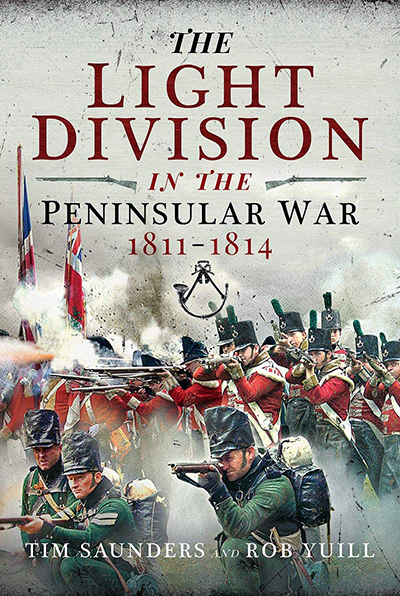Book
Review:
The Light Division in the Peninsular War
by Tim Saunders and Rob Yuill

 Britain's army in the Peninsular War is regarded as one of the best the island nation has ever produced.
Britain's army in the Peninsular War is regarded as one of the best the island nation has ever produced.
Forged in war and fired in battle, Sir Arthur Wellelsey's formations in Spain and Portugal saw off everything France and her marshals threw at them.
The battle honours speak for themselves: Rolica, Vimiero, Talavera, Badajoz, Ciudad Rodrigo, Salamanca, Vittoria ...
Of all the units that starred under the Union Flag between 1811 and 1814 the most celebrated was The Light Division, which was formed around the 43rd Monmouthshire Light Infantry, the 52nd Oxfordshire Light Infantry, and the 95th Rifles; and included at various times the 60th Rifles, Royal Horse Artillery, and light dragoons.
Created by Sir John Moore, its next most recognised leader was General Sir Robert Craufurd, an at-times controversial commander who seems to have been loved and hated by his men in equal measure.
The division was a highly mobile force and deservedly became feted in the British Army as its elite unit.
Its adventures have been brought alive in The Light Division in the Peninsular War, a really well written examination by Tim Saunders and Rob Yuill of the force's campaigns into which is woven first-hand experiences of its officers and troops.
I so enjoy this style of book as the first-hand accounts add colour and emotion to the historical details.
After the storming of Ciudad Rodrigo and the death of Craufurd, about 40 British deserters were captured.
According to Lt John Kincaid 10 of them were from the Light Division. Wellesley, or rather Lord Wellington as he had become, said any of them who could get references of good character from officers would be saved.
Six could not and were subsequently marched in front of the division and shot.
Lt George Simmons of the 95th tells of a move he made to keep French artillery from firing at his men while they dug trenches outside the city.
He watched until the artillerymen remove the gabions in front of their cannons and had his troops fire at the gaps. The effect of this was to keep the French guns silent through the daylight.
The description of the storming of Badajoz is fascinating, and awful, and sickening all at once.
What those troops thrown at the walls of that city did and survived was astounding. Little wonder there was so much brutality that followed, many aspects of it detailed by even more eyewitness accounts.
A wounded Riflemen Edward Costello tells of one incident in which British troops broke into a house and beat an old man until he gave them all his money. They then found the man's wife and daughters. "Without dwelling on the frightful scene that followed ..." I think we can all guess what happened.
After Badajoz you can follow the Light Division through the 1813 campaign, over the Pyrenees, into France, and on to Toulouse.
The Light Division in the Peninsular War has so many gems of information and insights into the campaigns in Spain and Portugal that every time you pick it up you discover something else.
The images of the major and minor characters bring extra life to those mentioned in its pages; and the maps and graphics allow you to get a handle a city, siege or event visually.
I have two suggestions if another edition is printed. Firstly the images are very grey and muddy and really deserve better production values. Secondly, as a lifelong journalist I got a bit miffed at often having to research the first names of people mentioned — Edward Costello and George Simmons to name but two.
Other than that this is a great read that will comfortably sit on my bookshelves.
-
Richard Moore
8.5/10
The Light Division in the Peninsular War, 1811-1814, by Tim Saunders and Rob Yuill.
Frontline Books, ISBN: 1 52677 013 4.
Pages: 346.
Illustrations: Too many to count.